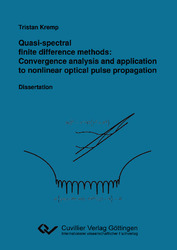| Departments | |
|---|---|
| Book Series (96) |
1378
|
| Nachhaltigkeit |
3
|
| Gesundheitswesen |
1
|
| Humanities |
2363
|
| Natural Sciences |
5406
|
| Mathematics | 229 |
| Informatics | 319 |
| Physics | 980 |
| Chemistry | 1363 |
| Geosciences | 131 |
| Human medicine | 243 |
| Stomatology | 10 |
| Veterinary medicine | 108 |
| Pharmacy | 147 |
| Biology | 835 |
| Biochemistry, molecular biology, gene technology | 121 |
| Biophysics | 25 |
| Domestic and nutritional science | 45 |
| Agricultural science | 1004 |
| Forest science | 201 |
| Horticultural science | 20 |
| Environmental research, ecology and landscape conservation | 148 |
| Engineering |
1791
|
| Common |
98
|
|
Leitlinien Unfallchirurgie
5. Auflage bestellen |
|
Advanced Search
Quasi-spectral Finite Difference Methods (English shop)
Convergence Analysis and Application to Nonlinear Optical Pulse Propagation
Tristan Kremp (Author)Preview
Table of Contents, Datei (120 KB)
Extract, Datei (130 KB)
The doctoral thesis „Quasi-spectral finite difference methods: Convergence analysis and application to nonlinear optical pulse propagation“ by Tristan Kremp addresses the theory and application of so-called quasi-spectral finite differences. Contrary to the common Taylor approach, these are by construction exact for trigonometric instead of algebraic polynomials. With any fixed discretization spacing, this allows for a higher accuracy, e.g., when differencing functions that have a band-pass like Fourier spectrum.
In this dissertation, the convergence of such quasi-spectral finite differences is proven for the first time. It is shown that the highest possible order of convergence is the same as for the Taylor approach, i.e., it is basically identical to the total number of summands in the finite difference. This order is achieved if all frequencies, for which the quasi-spectral finite difference is exact, vanish sufficiently fast in comparison to the discretization spacing. This condition can be easily incorporated in the finite difference weights construction, which can be achieved by spectral interpolation or least-squares optimization, respectively. Employing previously unknown Haar (or Chebyshev) systems that consist of combinations of algebraic and trigonometric monomials, the equivalence of both methods of construction is proven.
In a semidiscretization framework, these finite differences are, for the first time, combined with exponential split-step integrators for an efficient solution of linear or nonlinear evolution equations. It is shown that a simple modification of the common symmetric split-step integrator guarantees its second-order convergence even in the presence of general nonlinearities.
An important example of such a partial differential equation is the nonlinear Schrödinger equation (NLSE). In contrast to the standard literature, the NLSE is derived here directly from Maxwell’s equations, without the common assumption that the second spatial derivative in the direction of the propagation can be neglected, and without the assumption that the multiplicative nonlinear term behaves as a constant with respect to the Fourier transformation. A practically relevant application is the propagation of wavelength division multiplexing (WDM) signals in optical fibers. Compared to other semidiscretization techniques such as finite elements, wavelet collocation and the pseudo-spectral methods (split-step Fourier method) that are mostly employed by the industry, the quasi-spectral finite differences allow, at the same accuracy, for a substantial reduction of the computation time.
| ISBN-13 (Printausgabe) | 3869556854 |
| ISBN-13 (Hard Copy) | 9783869556857 |
| ISBN-13 (eBook) | 9783736936850 |
| Language | English |
| Page Number | 240 |
| Edition | 1 Aufl. |
| Volume | 0 |
| Publication Place | Göttingen |
| Place of Dissertation | Universität RWTH Aachen |
| Publication Date | 2011-03-25 |
| General Categorization | Dissertation |
| Departments |
Mathematics
|








